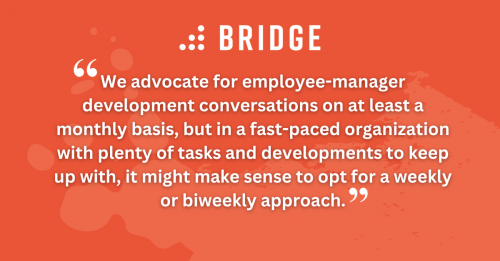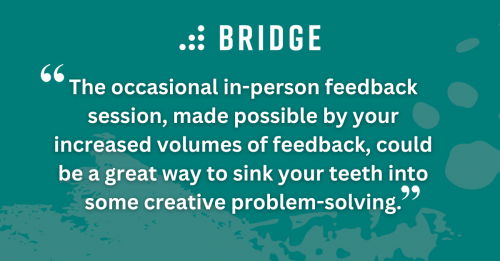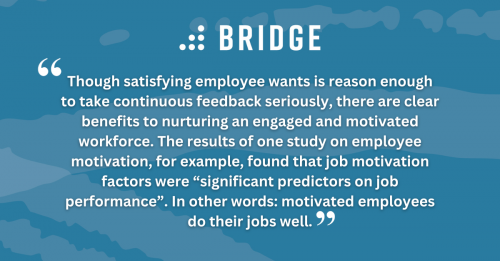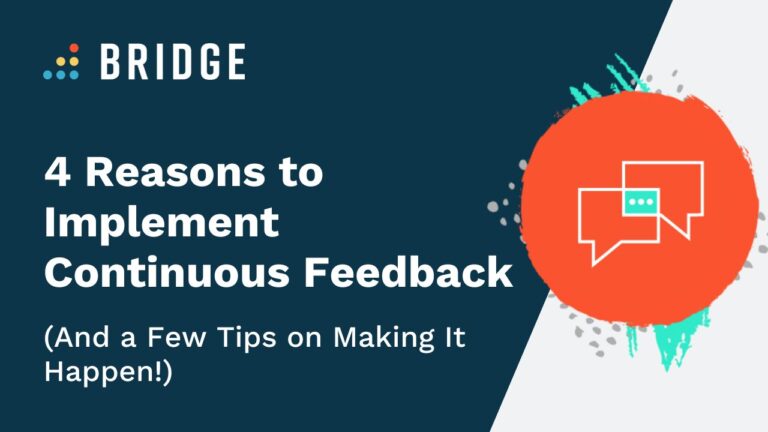Most people intuitively understand that feedback, when done well, represents a formidable asset in any organization’s performance management toolkit. In fact, 81% of employees believe effective feedback improves performance, according to a Gartner survey.
Despite a general awareness of its value, it’s easy to forget that feedback doesn’t just need to be delivered—it needs to be delivered often. After all, while we also intuitively understand the importance of eating vegetables, we know it’s not enough to eat broccoli on an annual basis!
That’s why organizations looking to take full advantage of feedback and any related benefits adopt a continuous feedback model. Continuous feedback refers to any feedback approach that emphasizes frequency, giving employees immediate input into their day-to-day trials and triumphs.
While it might sound like a simple matter of upping your 1:1s, this feedback model is at its most effective when it’s implemented properly—and with a firm understanding of the advantages it can unlock. That’s why we’ve put together a whistle-stop tour of both the ‘how’ and ‘why’ of continuous feedback.
How Do You Implement a Culture of Continuous Feedback?
There’s no right or wrong way to go about offering continuous feedback. As long as it’s delivered often, and in a way that makes sense for your organization, there’s plenty of room to maneuver—but there’s also plenty to consider.
It might be tempting to assume that upgrading your feedback frequency involves nothing more than throwing a few extra 1:1 slots into your managers’ calendars. However, while scheduling your meetings is absolutely a great way to ingrain new habits and make sure your continuous feedback program doesn’t fall by the wayside, that’s just the beginning of the process.
A good implementation of this expanded feedback system will involve a good cadence, the right structure to suit the tastes of your employees, and mediums that make sense for your organization.

Reflect on the Right Feedback Cadence
When it comes to frequency, you’ll have to balance a continuous approach against practicalities like the availability of managers or peers who might deliver employee feedback.
Here at Bridge, we advocate for employee-manager development conversations on at least a monthly basis, but in a fast-paced organization with plenty of tasks and developments to keep up with, it might make sense to opt for a weekly or biweekly approach.
MORE ABOUT 1:1s | ‘One-on-One Meetings: How the Personal Touch Improves Workplace Performance’
Structured vs Unstructured Feedback Styles
Do you prefer to have a rigid feedback format, complete with planned agendas and consistent talking points, or would you rather opt for a more relaxed, informal, and conversation-led style?
These options both have merit in a continuous feedback context. As your managers will need to get through a higher rate of feedback sessions, they may prefer a structured approach—perhaps supported by skill and career development plans allowing them to focus each meeting around specific employee goals and milestones.
Alternatively, you might want to incorporate a conversational approach that doesn’t look to hit specific topics but allows employees to share any thoughts or concerns that they need to get off their chests.
This more personal and supportive approach, combined with an increase in your feedback frequency, is a great way to build trust among your employees and managers, which—as Deloitte researchers suggest—can increase motivation by 260%, among a string of similar benefits.

Choose the Right Feedback Medium
For some organizations, adopting a continuous feedback model is a great opportunity to reflect on the medium through which feedback is conveyed.
For example, a hybrid workplace that ordinarily offers feedback through video conferencing might find that a higher volume of 1:1 meetings allows them to add in-person feedback sessions to the mix.
Researchers from Columbia Business School and Stanford Graduate School of Business have found that creativity can be a little stunted in video calls due to the narrow scope of the screens involved. As such, the occasional in-person feedback session, made possible by your increased volumes of feedback, could be a great way to sink your teeth into some creative problem-solving.
On the other hand, video conferencing allows managers and employees to easily review digital resources like Bridge’s Career Drivers Cards, enhancing the range of employee-manager feedback options without needing to peer across at one another’s screens.
GET YOUR MANAGERS FEEDBACK-READY | ‘Unlock Your Employees’ Potential With People-First Managers’
Why Is It Important to Provide Continuous Feedback to Your Employees?
Wherever it’s appropriate to receive constructive feedback, most people are eager to hear it.
A study published by the American Psychological Association (APA) tested people’s willingness to give feedback, even if it was a little critical. It did this by seeing if its subjects were prepared to mention an obvious but fixable blemish on their researchers’ faces (like smeared lipstick). Very few subjects pointed out the blemish, but a substantial 86% reported that they’d want to be told if the roles were reversed.
The researchers concluded that we tend to underestimate how much others value our feedback, even if it’s critical. The same will be true for your employees—and, if they want to know about any metaphorical blemishes on their faces, they probably don’t want to wait till their next biannual review to find out!
Quickly identifying fixable mistakes isn’t the only benefit of continuous feedback. By giving your people the input they need to grow and thrive, you’ll introduce an array of advantageous side effects into your organization. These effects reach beyond the simple fact that—as the APA researchers concluded—people want feedback more than we realize. Here’s a list of our four favorite outcomes.
1) Increased Employee Productivity
According to a study conducted by Harvard Business Review, employee recognition comes with a wealth of productivity-adjacent benefits relating to wellbeing, belonging, and attendance, adding to the substantial volumes of research demonstrating a positive correlation between praise and job performance.
As such, it clearly makes sense to offer praise to your employees. However, according to a study from scholars at the University of Southern California, only around half of all professionals are offered appreciative feedback (like a simple “thank you” from their bosses) on at least a weekly basis.
Does this mean most businesses are deliberately stingy with their praise, or that they’re unaware of the value praise brings to the productivity table? Not necessarily.
What this statistic could instead suggest is that organizations need to create good opportunities to offer praise more often. If formal feedback occurs on an annual basis, your opportunities for positive reinforcement only come along as often as, say, Easter. Continuous feedback ensures that your managers are never short of occasions to offer a metaphorical pat on the back almost as soon as it’s warranted.

2) Higher Retention Rates
McKinsey’s exploration of employee attrition suggests that one of the biggest factors in exit decisions is that employees don’t feel their leaders care.
It goes without saying that manager-employee feedback is, when handled correctly, a great way to fill the caring-shaped hole in the employee experience. Management scholars have corroborated this idea, pointing out that balanced feedback is a fantastic way to make sure employees feel valued.
The retention-related benefits of feedback might not be realized, however, if your managers only provide it sporadically. When feedback is a once- or twice-per-year event, it takes on the flavor of an HR obligation—far from the care and attention implied by frequent check-ins on both a formal and informal basis.
MAKE YOUR PERFORMANCE REVIEWS CONTINUOUS | ‘Why Performance Reviews Shouldn’t Be a Once-a-Year Deal’
3) Stronger Employee Engagement
One 2022 survey suggests that around half of employees feel more motivated after regular performance discussions with their managers.
The key word, here, is “regular”. The same survey found that 63% of employees specifically want “in-the-moment” feedback, which can only be achieved through consistent and frequent conversations about the topics, issues, and accomplishments that make up the recent past.
Though satisfying employee wants is reason enough to take continuous feedback seriously, there are clear benefits to nurturing an engaged and motivated workforce. The results of one study on employee motivation, for example, found that job motivation factors were “significant predictors on job performance”. In other words: motivated employees do their jobs well.
4) New Managerial Efficiencies
From a managerial perspective, it might sound counterintuitive to suggest that more frequent feedback can lead to less time wasted. According to Gallup, however, the traditional (read: infrequent!) form of delivering feedback is an “intimidating and overwhelming” prospect for managers who are required to review months of accumulated performance information for each of their reports.
By contrast, managers’ consistent engagement with their reports’ progress under a continuous feedback system ensures that everything they need to know is top of mind, reducing prep time while allowing for feedback based on a much more nuanced understanding of employee performance.
Want the Full Story on Continuous Feedback?
You’re just a click or two away! This blog post is a snippet of our ebook on continuous feedback, titled ‘Feel the Benefits of Continuous Feedback With These 4 Approaches.’ Download the full ebook for some in-depth guidance on the form your continuous feedback should take—and why it matters.




